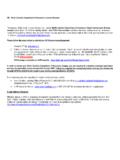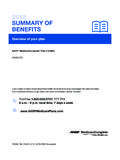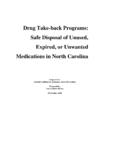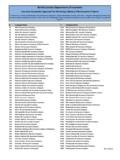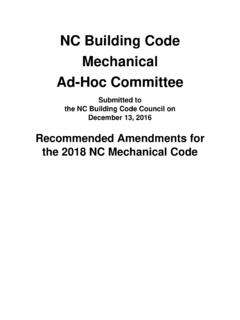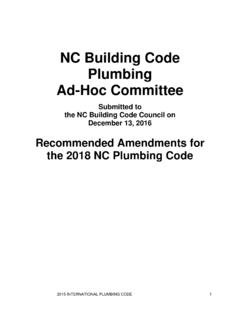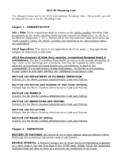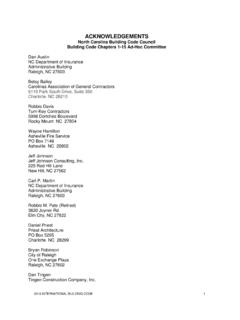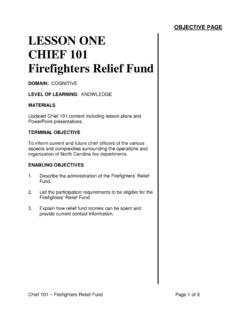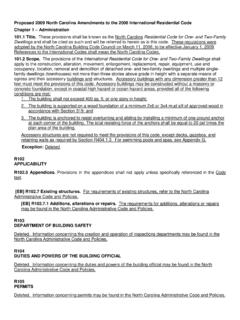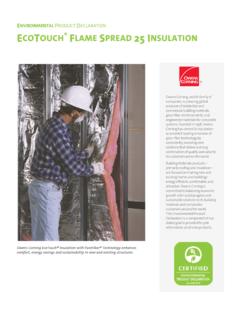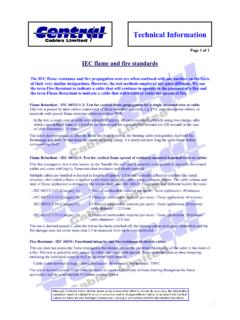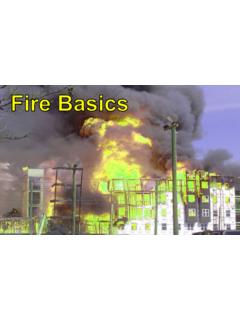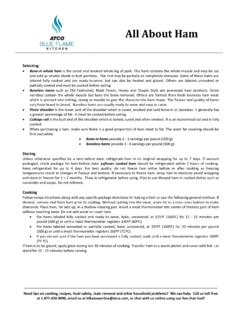Transcription of NCDOI OSFM Evaluation Services
1 File No. WP61-11 Material Combustibility Page 1 NCDOI osfm Evaluation Services Scope of DOI White Paper: The Purpose of this document is to provide clarification on North Carolina State Code requirements to Code Officials (CEO) who are agents for the Authority Having Jurisdiction (AHJ). DOI File #: WP61-11 Edition Date: 09/08/11, Revision 1: 12/05/11 Subject of White Paper: Classification of Building Materials According to Combustibility Contents Page Summary of Code Classes of Materials Commonly Encountered in Building A.
2 Non-Combustible B. Combustible C. Fire Retardant Treated D. Intumescent Descriptions of A. ASTM E B. ASTM E C. ASTM E D. NFPA Technical Photographic Introduction Chapter 6 of the North Carolina Building Code (NCBC) classifies buildings on the basis of the combustibility of the materials from which they are constructed. Classifications by materials are referred to as the Type of Construction of the building. Types I and II construction by definition require all structural (load-bearing) frame members to be non- File No.
3 WP61-11 Material Combustibility Page 2 combustible materials, , materials that do not readily burn. Exterior walls in Types III and IV construction are also required to be non-combustible. Other structural members in Types III and IV construction and all structural members in Type V construction may be combustible materials; that is, materials that readily burn. The amount of fuel available to feed a fire is known as the fire loading. Increasing fire loading increases the heat release and the smoke release of a fire. Higher heat and smoke release pose a greater hazard to building occupants and increase the difficulty of fighting a fire.
4 In an effort to limit fire loading, Table 503 of the NCBC limits the height and area of a building based on construction type and occupancy classification, both of which are an indication of the amount of combustible materials present in the building. Limiting the fire loading in a building increases the amount of time occupants have to exit the building, provides firefighters with more time for rescue, and limits the resources, including manpower, equipment and water, required to extinguish the fire. As an aid to the CEO, the remainder of this document deals with the classification of materials based on combustibility.
5 Emphasis is on testing required to establish non-combustibility, common materials considered to be non-combustible, and materials which may be substituted for non-combustible materials under certain circumstances. Summary of Code References (2012 edition) NCBC Section 602 Defines building construction types on the basis of materials and fire resistance ratings. NCBC Section 603 Lists exceptions to non-combustible materials in Type I and Type II Construction. NCBC Section Establishes ASTM E 136 as the test required for non-combustibility and references ASTM E 136 for passing criteria.
6 This section also establishes criteria for classification of composite materials as non-combustible. NCBC Section Allows NFPA 286 test as an alternative to ASTM E 84 to establish combustibility of finish materials, and provides acceptance criteria for the NFPA 286 test. NCBC Section Defines fire retardant treated wood in terms of an extended ASTM E 84 test and establishes labeling requirements. NCBC Section Allows passing NFPA 286, UL 1715, or FM 4880 as alternatives to providing a prescriptive thermal barrier for foam plastics.
7 NCFC (Fire Prevention Code) Section Allows use of intumescent coatings to achieve flame spread requirements in existing buildings, and requires maintenance of the coating. File No. WP61-11 Material Combustibility Page 3 Classes of Materials Commonly Encountered in Building Construction A. Non-combustible material A non-combustible material is a substance that will not ignite, burn, support combustion, or release flammable vapors when subject to fire or heat, in the form in which it is used and under conditions anticipated.
8 Any solid substance complying with either of two sets of passing criteria listed in Section 8 of ASTM E 136 when the substance is tested in accordance with the procedure specified in ASTM E 136 is considered to be non-combustible. 1. Passing Criteria #1: a. Weight loss of the specimen cannot exceed 50%. b. Temperatures on the surface of the specimen and at the geometric center of the specimen during the test may not rise more than 54oF (30oC) above the equilibrium temperature of the furnace measured prior to introducing the specimen.
9 C. During the first 30 seconds of the test, there can be no flaming from the specimen. 2. Passing Criteria #2: a. If more than 50% of the weight of the specimen is lost, the material may still be classified as non-combustible provided both of the following conditions are met. b. Temperatures on the surface of the specimen and at the geometric center of the specimen during the test may not rise above the equilibrium temperature of the furnace measured prior to introducing the specimen. c. No flaming from the specimen can occur at any time during the test.
10 3. Examples of non-combustible materials include: a. Portland cement concrete, gypsum concrete (normally used in drywall or poured gypsum floor toppings), or magnesite (magnesium oxide) concrete having aggregates of sand, gravel, expanded vermiculite, expanded or vesicular slags, diatomaceous silica, perlite, or pumice. This class of products includes Portland cement stucco, Portland cement plaster, and gypsum plaster, as well as concrete. b. Brick masonry, concrete block masonry, and ceramic tiles. c. Metals except aluminum (aluminum is classified as limited-combustible), magnesium and magnesium alloys.
